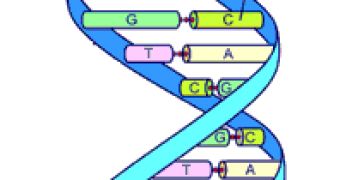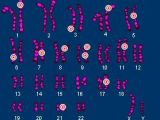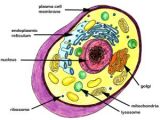Our bodies are a sort of machines constructed from a number a parts, called organs, working together. Each of these organs is made of certain types of tissues - groups of cells of a specific type. Unlike the organs or the tissues, each of these cells is a living creature similar to us. Each cell eats, breathes, grows, reproduces and eventually dies. Nonetheless, in spite of their huge diversity, all our cells have something in common - they all share the same DNA.
DNA, deoxyribonucleic acid, is a large molecule with a very simple structure which is found in the nucleus of each cell. It contains the instructions on how to build each of the cells - the processing of these instructions leads to a certain cell having a certain form and behavior. Each cell contains inside its nucleus the instructions on how to build any of the organism's cells - it contains the entire DNA and not only the parts it needs itself.
How does the DNA inside each cell know what parts of its code have to be processed? It doesn't. The key are the proteins floating around the DNA. They activate or inhibit the transcription of various parts of the DNA, called genes, into RNA - a molecule into which the gene in copied. The RNA drifts away and exits the nucleus and eventually bumps into certain structures floating around inside the cytoplasm of the cell. These structures, called ribosomes, interact with the incoming RNA and produce a particular protein. The ribosomes themselves are made of RNA and proteins (called ribosomal RNA and ribosomal proteins).
A cell is made from a large number of different types of proteins that interact with each other and with other molecules in specific ways. Ultimately, the form and behavior of each cell is determined in part by its proteins and in part by the external supply of other substances. Then, the construction of tissues and of organs is determined in part by the cell's behavior and form and in part by the supply of materials. And finally, the behavior and appearance of an individual is determined in part by the interactions between organs (such as the heart, the lungs, the stomach, the hands or the brain) and in part by external factors processed by the organs.
The brain is a relatively special organ, in that it controls much of what happens inside the organism (it controls the functioning of other organs - for example sending signals to the heart or activating or deactivating the digestive system) and it controls what the organism does as a whole (how it interacts with the external environment). In a certain sense one can say that the organs also influence what happens in parts of the brain, but this influence can be viewed as the brain informing itself about what happens in that organ and reacting to that information.
There is an interesting relation between DNA and proteins. DNA holds the information about how proteins have to be. Proteins are chains of aminoacids that fold into complex three-dimensional structures. A gene simply contains the information about the sequence of aminoacids. The ribosomes don't have to worry about the three-dimensional structure of the protein, they just have to add the aminoacids in the specified order and the laws of physics take care about the three-dimensional folding.
Among the most important proteins are the enzymes. These are catalytic molecules - they don't react with other molecules but offer a space for reactions to take place. Various molecules temporarily stick to certain places on the enzymes (which are huge molecules) and slightly change their form. As a result of this change of form the molecules can react more easily with other molecules. The products of these reactions then escape the enzyme and float away. By controlling the reactions in such ways enzymes create order out of the chaos of all these molecules floating from place to place at random.
The entire inner organism behaves like a very inefficient postal system: "letters" are sent at random in all directions and due to their sheer numbers they eventually reach their "destinations" - i.e. the enzymes that make them react to other molecules. Have you ever wondered how the aspirin knows how to go where it should after it's being digested? It doesn't know. It is taken by the blood stream and spread to every place in the body and thus eventually reaches the place where it does something. This is also how hormones "find their way" or how the immune system fights intruders.
Many of the substances needed by the organism for direct use (such as water, oxygen, vitamins or glucose) or used by the organism to synthesize other molecules (raw materials such as aminoacids or lipids) are taken from the outside. The reactions catalyzed by enzymes involve such raw materials and lead to other molecules the organism uses - molecules such as neurotransmitters, hormones, vitamin D and many others.
But, as noted, the entire process of creating a certain protein depends on other proteins and not on DNA alone. Moreover, the process of copying the DNA - that takes place during the reproduction of a cell - depends on proteins. Thus, the creation of proteins depends on DNA and the creation of DNA depends on proteins.
"Speaking crudely, a living system - an organism - consists of a symbiotic relationship between a metabolism and a replicator," wrote J. Doyne Farmer from the Santa Fe Institute. "The metabolism, which is built out of proteins and other stuff, extracts energy from the environment, and the replicator contains the blueprint of the organism, with the information needed to grow, make repairs, and reproduce. Each needs the other: the replicator contains the information to make the proteins, the RNA, and other molecules that form the metabolism and run the organism; and the metabolism provides the energy and raw materials needed to build and run the replicator."
The evolution of life involved the common evolution of DNA and proteins. The simplest forms of life we encounter today, certain very simple viruses, are nothing but a tiny DNA. They don't even carry around the proteins they need for reproduction. They reproduce only when they happen to encounter such proteins in their environment - for example when they end up in other cells and hijack their reproduction machinery. The first cells were little more than a solution containing the DNA and some proteins enveloped by a membrane. The first cells with nucleus appeared more than one and a half billion years later (around 1.6 - 2.1 billion years ago) and probably were the result of trapping a virus inside the cell - the virus combined with the cell's DNA and formed the nucleus. There still are lots of bacteria today that have no nucleus.
It is interesting to note that most of the genes that code for essential proteins in our bodies, proteins that are needed for example in digestion, are not part of our DNA. Especially after birth, our bodies are colonized by a large number of bacteria that live inside us and which form a symbiotic relation with our bodies. Scientist found that up to 100 trillion microbes live inside our gut, representing more than 1,000 species. The sum of all these microbes includes more than 60,000 genes - twice as many as found in the human DNA.
Besides the genes that code for certain proteins, there are some genes, called non-coding genes, that act only as templates for the RNA. In the typical process, the gene's DNA sequence is transcribed into a messenger RNA molecule, which then guides the synthesis of a specific protein. But in case of non-coding genes the RNA molecules themselves have special properties and biological effects - they are called functional RNAs. Unlike DNA which is double stranded, the RNA has only one strand. This allows it to fold in a 3D structure - various parts of the single strand connect to each other using the same kind of base pairing that holds together the double-stranded helix of DNA. The outcome is a stable 3D structure able to interact with proteins and other molecules. (Scientists are also able to synthesize such RNA structures which are very useful, e.g. to be used in biosensors, due to their diversity - they are called aptameters.)
The DNA encodes the traits that characterize an individual in an indirect manner. Sometimes this can be very indirect and the external environment is involved in each step. An example where the connection between DNA and a trait is relatively short is the eye color: the eye color is determined by at least three genes that code for the proteins in the iris (especially melanin) - people with large amounts of melanin have brown eyes, while people with small amounts of melanin have blue or green eyes. An example where the connection is longer is weight or height: the diet of the baby can activate certain genes and eventually lead to a larger adult (the organism "gets the signal" that it is developing in certain environmental conditions and "decides" to develop toward a larger individual, otherwise it might "decide" it is safer to prepare for a world of more limited resources).
Thus, the DNA doesn't contain the information about how the organism will look and behave, but the information about the available options. The environment then influences which of these options is actually followed.
The mental abilities, such as intelligence or various kinds of talents, or inabilities, such as autism, are the result of the organization of the brain. However, the exact process by which the brain develops, a process which involves the use of genetic information, is not known in very much detail. We also have a limited knowledge of the exact correlations between the brain structure and various mental abilities.
Nonetheless, although in many ways we're just at the beginning of the journey, scientists have unraveled some interesting facts about how the organism gets from the genes to the brain. For example the biochemical mechanism of depression is now known. It also seems that conditions such as autism are genetic - in other words, all the options for development present in the autistics' DNA lead to a brain which has low interconnectivity between various brain areas. On the other hand, some abilities traditionally considered to be genetically determined, such as many talents, now seem to be more likely the result of intense training. Scientists have also determined the unfortunate influence various substances, such as alcohol, have on the development of the brain. But there are still many more things to be learned about how the genes and the proteins interact with the environment to produce their effects on us. In some sense we are the stage on which this play takes place and in some other sense the play itself is us.
See an animation from Nature about gene expression here.

 14 DAY TRIAL //
14 DAY TRIAL // 


